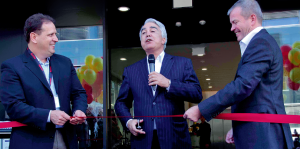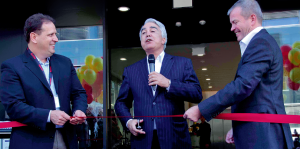A relocation to Eysins in Switzerland will help Kodak conquer markets such as the Middle East, CEO Antonio Perez tells Benjamin Daniel.

Underlining its recovery from Chapter 11 bankruptcy, Kodak has inaugurated a new headquarters in Switzerland that brings together the core of the firm’s business with a showcase for its technology.
On 21 October, the revived digital giant hosted a grand opening for the new facility at Eysins, on Lake Geneva in Switzerland.
Solutions on demonstration at the new headquarters include the NexPress SX 3300 digital production colour press, the Prosper 5000XLi press, the Prosper S-Series imprinting systems (S5 and S10), the Versamark VL4000 printing system and the Versamark VX5000 Plus printing system, alongside samples printed with Sonora XP process free plates imaged on the Magnus Q800 platesetter with Multi-Cassette Unit (MCU), the FlexCel NX Wide Imager (Q4) and all Kodak’s unified workflow solutions.
For CEO Antonio Perez, this showcase will bring home to visitors Kodak’s unique expertise in digital solutions, he told Packaging MEA.
“In packaging, we have one of our key technologies, the continuous inkjet technology, originally designed with the name Stream,” he said.
“This is the fastest printing technology in the world. There is nothing even remotely close. Other technologies don’t work with frequencies, on paper, higher than 60KHz, actually practically 40Khz. So they give just 40,000 drops of ink per second compared to our 14.1 billion drops of ink per second.”
Packaging printers can also benefit from integrating Kodak printing systems with the company’s imaging and workflow products, he added.
“Next we have the FlexCel NX, which gives you the qualiy of gravure at a tenth of the cost, and ColorFlow software, another key technology supplying all the needs of this industry,” he said.
Partnerships will further enhance Kodak’s portfolio for the sector through opening up saving through variable printing, he said.
“With the Prosper press we are progressing in digital packaging,” he said.
“We are working on partnerships in the markets for large industrial applications such as laminates that should be done with a variable data printing technology that will be much more effective.
“It not only gives you the advantage of customisation but also helps you in eliminating a tremendous amount of waste because you only print on materials that you need and you print it as you want it to be done in volumes.”
Smart packaging is another promising development for the sector, he added.
“Imagine the things we can do when we apply the same notion of functional printing to packaging,” he said.
“So packages can now actually talk to you or recognise you or have antennas that would link the product that you just bought to another product of the same company. Or maybe you just press your finger on the label and you can see the history of the owner or read a recipe or get lead to a promotion.
“You can also print a sensor as you print a label to indicate the freshness of the product. With technologies like square spot we can print complete printed electronics – not today, but we are going towards it. It is all in printing. Printing for Kodak is the ability to transfer any kind of substrate on any material for all sorts of applications.”
High-growth regions
In the meantime, with its current portfolio, Kodak has developing economies firmly in its sights, says Phil Cullimore, managing director for Europe, Middle East and Africa (EMEA).
“We see the MEA region as a high growth region,” he said.
“The high growth economies in EMEA are the eastern European countries, Middle East and Africa region and Greater Russia. In 2009 we had less than 10% of our workforce actually in those regions. In 2014 it will be 23% of our employees.”
The trend can also be seen in sales of presses, he added. “In 2009, less than 10% of our Kodak Nexpress Digital production press sales each year were going to high-growth economies,” he added.
“Last year more than a third of the Nexpress that we placed into our markets went into our high-growth markets, most of them into Middle East and Africa.”
Seeking ‘shelf pull’
For Cullimore, Kodak’s success in these markets will come from helping packagers improve their production, rather than just cut their costs.
“You can think about the top ten packaged goods companies in the world – in some region or the other they have all been to a Kodak technology innovation centre like the one here in Eysins,” he said.
“We need to keep challenging the industry to get out of its complacency… As an industry, we are our own enemy because there is no innovation so everyone starts to compete on ‘How low can I make my unit cost per package?’ and compete on cost efficiency.”
In his view, “a better way” to win jobs is to offer an improved “shelf pull” that can get products flying faster off the shelf.
“That’s actually worth a lot more to the brand owner than a few dollars off the package price,” he said.
He sees NX technology as “a perfect storm product”. “Though you pay a but more for it and the consumables, it gives you savings in your press room and your customers are going to satisfied. It’s a product that sells itself from the brand owner back.”
Collaborations in new sectors
Kodak’s current innovations include collaborations with firms such as Bobst, Presstek and Uteco.
With Uteco, Kodak is now providing a solution for digitising flexible packaging, said Collimore. Bobst and Kodak have inked a deal for new solutions in flexible, folding carton and corrugated applications.
Inkjet labelling is another area Kodak could enter through a tie-up, said Collimore. “It is an interesting
market,” he said.
“The label business is a brilliant application for us to partner with someone else, perhaps more than partner.”
In CTP, Kodak is also open to building partnerships, he added. “One of the changes between the old Kodak and the new Kodak is to say that the new Kodak is very nimble and very agile because of a change in thinking and philosophy,” he said.
“Today the majority of CTPs that get sold are sold under our brand and that is going to continue. But there’s nothing to stop us from partnering in the prepress the way we’ve partnered in the packaging market.”
Turning the page from Chapter 11
For Perez, Kodak can offer “a phenomenal portfolio of products based on breakthrough technologies”.
“One of the thing we have created for our customers along with the breakthrough technologies is the ability to deal with the breakthrough technologies,” he said.
“We’ve been working very hard in the market for the last 7-10 years to build this.”
In 2013, despite the post-Drupa hangover, this portfolio is enabling Kodak to meet its goals for the year, said Olivier Claude, general manager for print and VP for commercial business, EAMER.
“In this perspective, we’ve done really great,” said Claude.
“I would say, for 2013, we’ve made our budget in Europe, which was good we had a very strong Drupa year.”
The high cost of borrowing currently presents a further hurdle in converting orders into installations, he added.
In packaging, though, Perez sees Kodak’s outlook as secured by the quality of its print.
“The effect of image quality in packaging is what the marketer is looking for,” he said.
“It’s the most important piece of marketing that you are going to have. It will be there right on the shelf showing who you are.”



